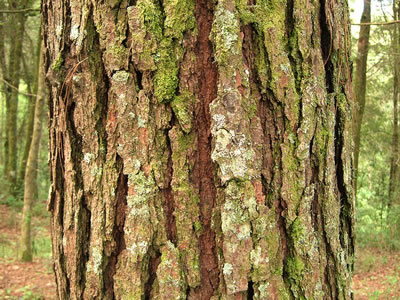Tree bark protects the tissues of a tree from weather extremes, from disease and from attacks by animals.
Bark consists of two layers. The inner layer consists of living tissue. It is known as the phloem. The outer layer is made up of dead tissue.
The phloem transforms sugars from the leaves to other parts of the tree.
 The outer layer is waterproof, which prevents the living tissues from drying out.
The outer layer is waterproof, which prevents the living tissues from drying out.
In parts of the world where there are seasonal forest fires, some trees have very thick bark, which acts as insulation against heat. The cork oak of the Mediterranean region is an example of one of these trees.
Trees with thin barks often have much thicker barks near the base of the trunk. This helps protect the tree against large herbivores.
How Tree Bark is Formed
Underneath tree bark, there is a layer of wet, green tissue known as bark cambium or cork cambium. The bark cambium creates corky cells. The bark cambium, together with these cells, is known as the periderm.
When a tree is young, the periderm first appears in the outer tissues of a shoot. Waxes and other materials in the periderm cause the color of the shoot to change, usually from green to grey.
In most trees, a succession of periderms arise one after another, each coming from deeper and deeper layers of the stem.
Periderms contain lenticels, small pores that allow gases to be exchanged with the outer atmosphere.
As each periderm forms, the tissue layers outside it die because they can no longer receive water or nutrients.
New layers of bark are always being created in the stem. This causes the bark to increase in size.
In some trees, old layers of bark easily peel or break off.
With other trees, the older layers remain attached so that the bark becomes very thick. These trees often have cracks in their bark because the trunk grows faster than the outside layers of bark can expand.
Uses of Tree Bark
The most famous product made from tree bark is latex, which comes from special cells in the phloem. Latex is used to make such products as rubber and chewing gum.
Maple syrup and turpentine also come from tree bark phloem.
Some tree barks have aromatic properties. These include the barks from which cinnamon and myrrh are produced.